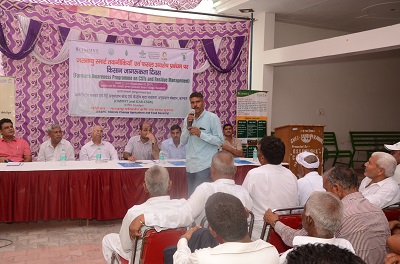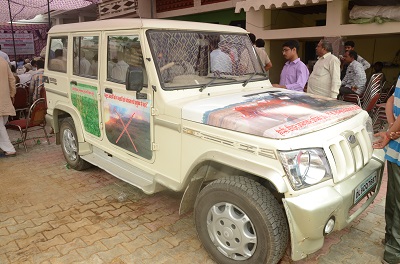
SAMBALI, India (CIMMYT) – In the 1960s, India became the center of the Green Revolution by adopting high-yielding crop varieties and new technologies and practices that staved off famine for millions.
Today, India needs a new Green Revolution.
The country’s combination of high greenhouse gas emissions, vulnerability to climate change and pressure to feed nearly 2 billion people by 2050 is driving farmers to find ways to grow more food in harsher environments.
Climate-smart agriculture is a new approach to farming that combines adaptation options that sustainably increase productivity, enhance resilience to climatic stresses and reduce greenhouse gas emissions. This option is becoming increasingly popular among smallholder farmers, who make up nearly 80 percent of India’s farmers and produce more than 40 percent of its food.
Harynana is a north-western state in India, and part of the Indo-Gangetic Plain, which covers an area of over 2.5 million square kilometers and feeds 500 million people. The village of Sambali, in Haryana, is one of the first communities in India to officially become “climate-smart” as part of the CGIAR Research Program on Climate Change, Agriculture and Food Security project (CCAFS), which is helping smallholder farmers globally find practical adaptation options to improve food security and resilience to climate change effects like drought, flooding and other extreme weather events.
In Sambali, more than 60 percent of the population depends on agriculture for their livelihoods. For over 50 years, farmers from the village have worked with Indian Council of Agricultural Research-Central Soil Salinity Research Institute (ICAR-CSSRI), this long-term knowledge exchange and exposure has resulted in 45 percent of the farming community practicing climate smart farming.
However, residue burning – the burning of excess residue on fields after a crop is harvested, as a means to clear the area to plant the next crop – remains a common practice in highly cultivated regions in India. Sambali becoming a residue-burning free village is setting an example of a model village contributing towards a healthier environment.
Besides triggering costly respiratory ailments in humans and animals in farm regions and urban centers, burning rice residues has negative agricultural implications. For example, residue burning depletes soil nutrients, with estimated yearly losses in Punjab alone of 3.9 million tons of organic carbon, 59,000 tons of nitrogen, 20,000 tons of phosphorus and 34,000 tons of potassium, according to M.L. Jat, a principal scientist at the International Maize and Wheat Improvement Center (CIMMYT), who leads CIMMYT’s contributions to CCAFS’ climate-smart villages in South Asia.
In response, a CIMMYT-CCAFS campaign was recently organized in Sambali to eliminate residue burning and combat its harmful effects to the environment, soil and human health.
It is advisable to have one percent organic matter in soil to assist conservation and increase productivity. According to Sunil Mann, the State Development Officer of the Department of Agriculture in Haryana, there has been a decline in organic matter in this region due to burning from one percent to less than half of one percent, highlighting a significant threat to soil health and productivity. The challenges of burning are exacerbated by the risk of areas turning into ‘dark zones,’ areas where groundwater has been over-exploited, due to the declining water table.
Hanuman Sahay Jat, a Scientist at CIMMYT, expressed concerns about the amount of chemicals released while burning crop residue and emphasized the need to stop this practice and adopt residue and nutrient management strategies. One way to achieve this is by using technologies like the GreenSeeker, a compact sensor that quickly assesses crop vigor and calculates optimal fertilizer dosages, to reduce dependency on chemical fertilizers and improve soil health.

M.L. Jat also highlighted the need for all stakeholders to do cost-benefit analyses before adopting new technologies. Farmers should ensure that profits will be worth investments in new technologies and researchers should ensure the efficiency and environmental impact of new technologies. For example in Basmati rice growing areas, zero-till machines, which help farmers plant new seeds directly in the residue of their previous crop’s harvest, are half the cost of the traditionally used “turbo happy seeder,” saving farmers money.
A positive result from Sambali will gain political attention and is likely to contribute to the development of new policies favoring climate-smart agriculture and their efficient utilization.
A “Climate Smart Van” was also launched during the campaign, which will drive through villages to spread knowledge, garner support and clarify the aspects of climate smart agriculture.
Sambali and other villages are taking steps towards integrated farming, with stakeholders’ engagement focusing sustainable development and scaling climate-smart agriculture practices while including women in decision making and engaging youth with profit-making opportunities.
 Capacity development
Capacity development